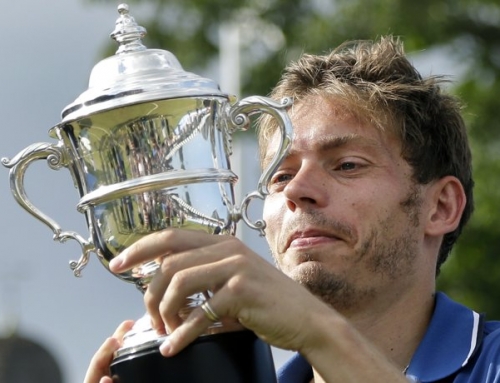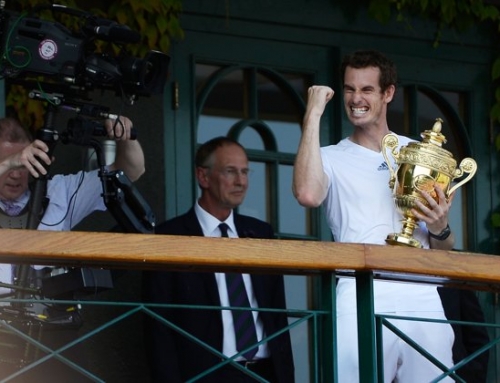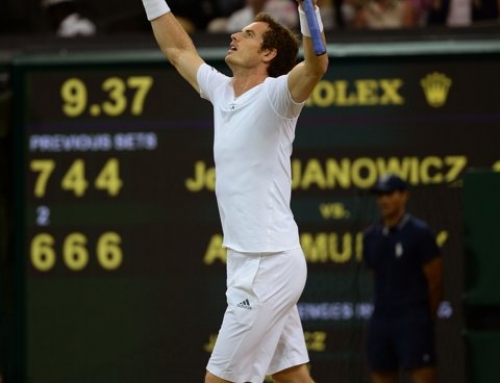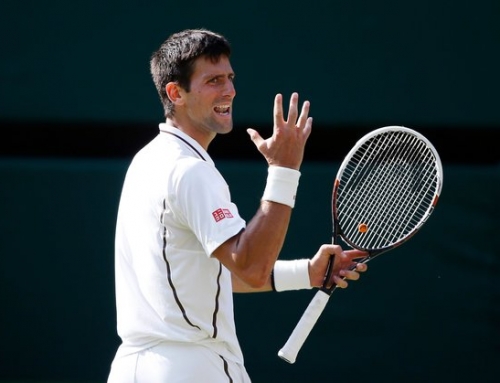 Everyone felt that the easiest of the quarterfinals was Novak Djokovic vs. Yen-Hsun Lu. Lu was reaching his first quarterfinals ever. He had upset Andy Roddick. Novak had just come off a solid win over Lleyton Hewitt. He had not reached a semifinals in quite some time. This was a perfect chance for Djokovic to win, and he made short work of Lu who was probably not over the thrill of upsetting Roddick.
Everyone felt that the easiest of the quarterfinals was Novak Djokovic vs. Yen-Hsun Lu. Lu was reaching his first quarterfinals ever. He had upset Andy Roddick. Novak had just come off a solid win over Lleyton Hewitt. He had not reached a semifinals in quite some time. This was a perfect chance for Djokovic to win, and he made short work of Lu who was probably not over the thrill of upsetting Roddick.
Beyond that, there was some thought that Soderling, given his hard hitting style, could beat Nadal. That didn’t happen. There was also some thought that Federer, who had had trouble playing Berdych, might lose, though most felt Federer would rise up and play well given his wins over Clement and Melzer. That didn’t happen, partly because Berdych played mentally tough, and Federer was unable to repel the Berdych firepower.
That lead to the only upset in the quarterfinals, a four set win by Berdych over Federer. Let’s preview the men’s semifinals.
Berdych-Djokovic
This will be the first match up tomorrow. It seems strange, for a guy that upset Roger Federer, that Berdych is considered an underdog against Djokovic. Before the tournament started, many felt Djokovic would not reach the semifinals. Djokovic has a reputation of fading due to fitness issues. He had to retire in the 2009 Australian Open against Andy Roddick. Although he completed the 2010 Australian Open, he faded badly against Jo-Wilfried Tsonga in the quarterfinals.
Much like Andy Murray, Novak Djokovic did not have a good year after the Australian Open. He did defend his title in Dubai, but lost early in Indian Wells (to Ljubicic, who went on to win the title) and in Miami (to Olivier Rochus). He also lost somewhat early in the various clay events (twice to Verdasco, once to Krajinovic). Djokovic had a chance to reach the semis, but couldn’t close the deal against Melzer.
And much like Andy Murray, Djokovic seems to have found form at Wimbledon. He started off shaky, going to five sets against Olivier Rochus, the man who beat him in Miami. Many thought that close call showed a lack of form for Djokovic, and thought it boded badly, even though Federer had an even closer call, and nearly lost to Alejandro Falla. It’s just that history shows that Federer gets into tight matches, finds ways to win, and goes deep.
There are plenty of examples of Federer doing this. His five-setter against del Potro and Haas in last year’s French Open. His five-setter against Tomas Berdych in the 2009 Australian Open. His five-setter against Igor Andreev in the 2008 US Open. When Roger gets into trouble, fans are willing to trust that his game is still there, and he can pull it through.
Djokovic began to turn some of this perception around as he progressed through Wimbledon. He had an easy match against Taylor Dent, an aggressive player with a big serve. He manhandled Albert Montanes who beat Roger Federer at Estoril. It was thought Djokovic would lose to Hewitt in the fourth round, despite having a good win-loss record. Hewitt had beaten Federer in Halle this year, and he had reached the quarterfinals of Wimbledon last year, pushing Andy Roddick to five sets. It was thought that his prowess on grass and Djokovic’s shaky health and confidence would do him in.
And yet, it was Hewitt, in the end, that got nervous. Djokovic would lose the third set when his upset stomach distracted him from good play, but he would break Hewitt early in the fourth. When Hewitt broke back, it seemed Djokovic might have to play a fifth. But in a game that Hewitt started 30-0, it was Hewitt that lost it mentally. He hit three errant groundstrokes in a row, then double-faulted to hand the break to Djokovic who then served for the match.
Djokovic’s groundstrokes and serve seem to be returning to the form it was at the end of last year. For a while, Djokovic seemed lost as he worked with Todd Martin to change his serve motion. He broke ties with Martin shortly after Miami, and has spent the next two months trying to get his game back to where it was.
Djokovic then easily handled Lu in the quarterfinals and had the easiest match of all the quarterfinalists.
Tomas Berdych made a splash 6 years ago in the 2004 Olympics when he upset Roger Federer. He gave Roger Federer a scare in the 2008 Australian Open when he seemed to have Federer struggling. However, he faded in five sets. In Miami, this year, Federer had a match point against Berdych, but eventually lost to Berdych. This win seems to have given Berdych confidence.
In this year’s French Open, Berdych didn’t drop a set until he lost to Soderling in the semifinals. En route, he beat John Isner easily, 6-2, 6-2, 6-1 in the third round, beat Andy Murray in straight sets in the fourth round, and beat a tough Mikhail Youzhny in straight sets in the quarterfinals. Despite this, and despite pushing Soderling to five sets, no one gave much thought to Berdych.
Berdych skipped the grass court tuneups. Wimbledon was the next tournament that he played in. Even though he had an excellent French Open, few picked Berdych to go far, preferring to pick Marin Cilic, who did play a grasscourt tuneup, and lost early there, and similarly lost early at Wimbledon.
Berdych did not have as easy a road to the semifinals as he did in the French. He was down 2 sets to 1 against Denis Istomin in the third round and was in danger of going down 2 sets to 1 against Daniel Brands in the 4th round, but won that in 4 sets. When he reached the quarterfinals, many thought, well, Berdych is good, but this is Wimbledon, and this is Roger Federer, and he just had two easy wins over Arnaud Clement and Jurgen Melzer. Few seemed to care that both players were older than Roger Federer. Berdych won in four sets despite Federer having opportunities to break in the fourth set and push it to a fifth. He played as mentally tough as he has in a while.
How will Djokovic be different? Djokovic has a few things he does better than Roger. Roger may be a surprisingly offensive groundstroker, but Djokovic is very steady and quick off the ground. Roger seemed half a step slow trying to chase down Berdych’s shots. Many of Berdych’s shots were hit to the Federer backhand. Djokovic has a two-hander, so he’ll be able to hit those returns back more authoritatively. Djokovic has one of the best backhands in the game, up there with Nadal.
Djokovic also returns quite well. Federer isn’t a bad returner, by any means. He’s better than, say, Andy Roddick, whose return game probably prevented him from being a better player than he is (and certainly contributed to his loss to Lu). But Djokovic, Murray, and Nadal are generally better returners.
Djokovic also has a good head-to-head record against Tomas Berdych, with a 2-0 record against him. But, Djokovic hasn’t faced Berdych since 2009 in Miami. Berdych appears to finally have worked out his mental toughness problems. Djokovic said one reason he beat Berdych was his inconsistency. He used to make quite a few unforced errors. Now he’s cleaned up his errors some.
I think this match is a tossup. I expect it to be close. Berdych’s big weapon is his first serve (and forehand) which he hits as big as anyone. He generally serves under 60% first serves. His second serve is more vulnerable. He was winning less than half his points against Federer and against Istomin, and that is what Djokovic will want to key in on. Djokovic generally serves between 60% and 70% of his first serves. He doesn’t win nearly as much on first serves, usually somewhere between 70% and 80%, but he usually wins 60% or more on his second serve. His winning percentage on second serves was notably weaker against Hewitt and Rochus.
The wildcard? Djokovic’s health. It may rain tomorrow in London, so heat may not be a factor.
Slight edge to Djokovic.
Murray vs. Nadal
Everyone’s looking at this match as the one to watch. Murray is in his second straight Wimbledon semifinals, courtesy of a somewhat friendly draw. Jo-Wilfried Tsonga was his first tough opponent, and tried to take the game to Murray, hitting big groundstrokes, and heading to net. Murray lost the first set in a tiebreak, but turned the second set tiebreak around when Tsonga approached the net and let a ball that looked like it might float long go, only to watch it land on the line. Murray took the second set, and from then on, it was all Murray. Tsonga faded badly afterwards, losing sets 3 and 4 by the identical set scores of 6-4.
Of the four semifinalists, Murray is the only one not to have been pushed to five sets. Djokovic had a five setter in the first round. Berdych had a five setter against Istomin. Nadal had a five setter against Haase and Petzschner. And, yet, he’s considered something of an underdog because Nadal came back to beat Robin Soderling. Nadal was particularly stingy on errors, and Soderling was having trouble trying to outhit Nadal.
Murray, for his part, will look at his last two meetings with Nadal in Slams. In this year’s Australian Open, Murray took the offense against Nadal, and played aggressive tennis. In the middle of the match, they paused to show fireworks, with the score, 6-3, 2-3 to Murray. Murray would come back afterwards and lose his serve to 2-4, but then break Nadal in the following game to get to 3-4, then both players held to the tiebreak which Murray won. By the third set, Nadal chose to retire, saying his knee bothered him and it was not worth continuing, down two sets to love.
The knee might be an issue again. Nadal has already chosen to take himself out of Davis Cup play and he blamed some of his poor play (like Federer) on injuries, in particular, during his match against Petzschner. Nadal seemed on a quest to win his next match (against Mathieu and then Soderling) easily to avoid questions of his knee, but it may eventually cause his problems in the Murray match.
However, Nadal looked very solid against Soderling. Nadal is healthier than he was when he faced Murray in Australia and when he faced him in the 2008 US Open semifinals. He may have also had time to think about how he wants to play Murray.
Murray, for his part, needs to serve a reasonably high first serve percentage. Murray generally serves a pretty low first serve percentage. He gets away with it, to some degree, because he has a pretty high win percentage on his second serve. Against Querrey, Murray had his lowest first serve percentage, at only 45%. He won primarily because he returned Querrey’s second serve so well. And he’ll need to do the same against Nadal.
Like Soderling, Murray has said that Nadal doesn’t have the best serve in the business, but Nadal is generally effective with that serve. He keeps his first serve percentage in the 70% range and moves around that first serve.
Nadal’s not the kind of guy that loses easily, but he can win easily. I expect a four setter and favor Nadal. While I think Murray can beat Nadal, I think Berdych’s chance of winning are just a little higher than Murray.
Murray is not quite playing as well as he did in Australia, but he has found some form, and he will rely on the British crowd to play an exceptional match. I think he’ll need a little luck too. For one, he’ll hope there is no rain tomorrow. There’s a prediction of rain which may cause the roof to close. This raises the humidity and makes the conditions slower, which would favor Nadal.







